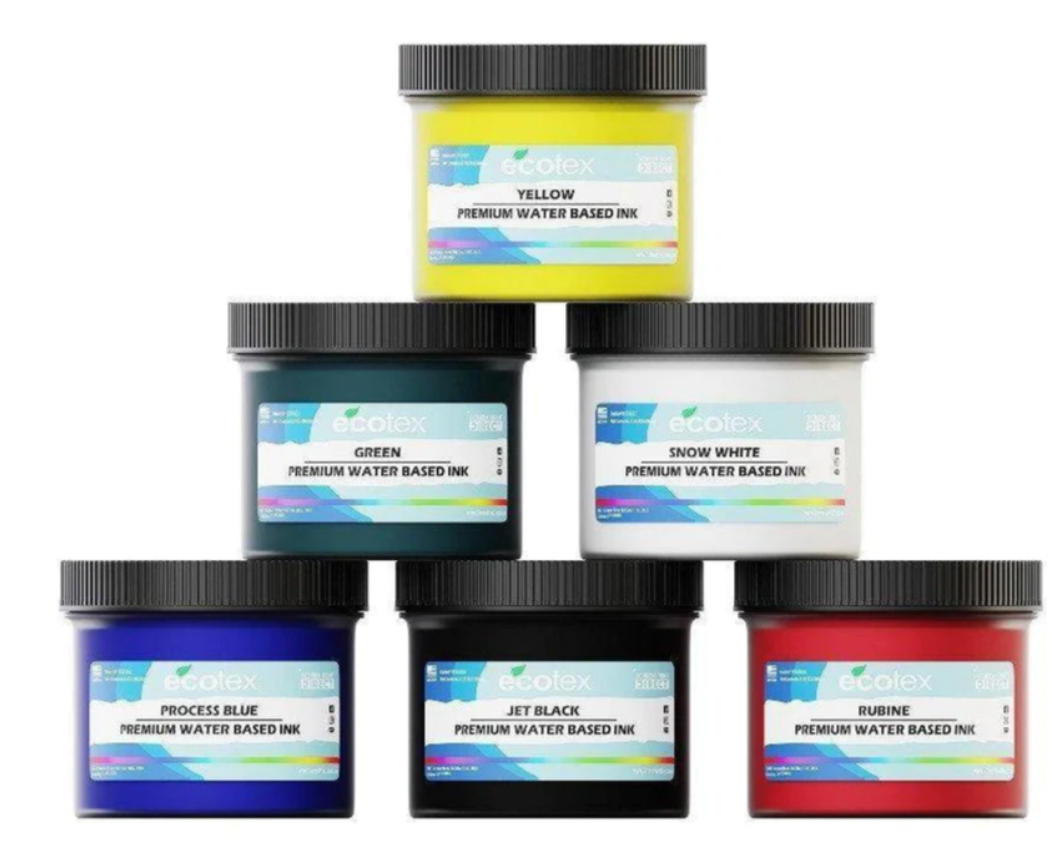Introduction
Screen printing is an age-old technique used for creating vibrant designs on various materials, including garments, glass, ceramics, and more. As the technology advances, so does the need for more sustainable, eco-friendly, and high-performing materials. One such material that has emerged as a promising contender in the world of screen printing is water-based ink. In this article, we'll explore why water-based screen printing ink is the future and how it compares to its traditional counterpart, plastisol ink.
The Evolution of Screen Printing Inks
Plastisol Inks
For decades, plastisol inks have dominated the screen printing industry. Made from PVC (polyvinyl chloride) resin and plasticizers, these inks are known for their durability, vibrant colors, and ease of use. However, as environmental concerns become more pressing, plastisol inks' sustainability and safety have come under scrutiny.

Image of Plastisol Inks
Water-Based Inks
Enter water-based inks. These inks are not only better for the environment but also provide several advantages over plastisol inks. As a result, water-based inks are quickly gaining popularity in the screen printing world.

Image of the Future - Water-Based Inks
What is Water-Based Screen Printing Ink?
Composition and Characteristics
Water-based inks are made from water-soluble pigments or dyes that are suspended in a water-based medium. Unlike plastisol inks, which contain PVC and plasticizers, water-based inks are free of harmful chemicals and are generally considered more eco-friendly. They also offer a softer feel, breathability, and durability.
Types of Water-Based Inks
There are two primary types of water-based screen printing inks: dye-based and pigment-based. Dye-based inks are known for their vibrant colors and penetration into the fabric, while pigment-based inks offer a more opaque finish and better durability.
The Advantages of Water-Based Screen Printing Inks
Environmental Friendliness
As mentioned earlier, water-based inks are free of harmful chemicals like PVC and plasticizers, making them more eco-friendly. Additionally, they require less energy to cure and generate less waste than plastisol inks.
Softer Hand Feel
Water-based inks penetrate the fibers of the fabric, resulting in a softer hand feel compared to plastisol inks, which sit on top of the fabric. This makes water-based prints more comfortable to wear.
Breathability
Water-based inks' ability to penetrate the fabric also allows for better breathability, making garments printed with water-based inks more comfortable to wear, especially in hot and humid conditions.
Durability
Water-based inks have excellent durability and can withstand numerous washes without fading or cracking. This makes them an ideal choice for printing on garments that require frequent washing, such as activewear or workwear.
Versatility
Water-based inks can be used on a wide range of materials, including natural and synthetic fabrics, as well as non-textile surfaces like paper, wood, and glass. This versatility makes them an attractive option for various screen printing applications.
The Challenges of Water-Based Screen Printing Inks
Longer Drying Time
One of the primary drawbacks of water-based inks is their longer drying time compared to plastisol inks. This can slow down the production process and may require additional equipment, such as forced-air dryers, to speed up the process.
Learning Curve
Switching from plastisol to water-based inks may require some adjustments in the printing process and techniques, as water-based inks behave differently than plastisol inks. Printers need to learn how to handle these differences to achieve optimal results.
Innovations in Water-Based Inks
As the demand for water-based screen printing inks grows, so does the need for innovative solutions to address their challenges. Advancements in ink formulations and drying technologies are helping printers overcome the longer drying times and learning curve associated with water-based inks.
The Future of Water-Based Screen Printing Inks
As the screen printing industry continues to evolve, water-based inks are expected to play an increasingly significant role. With their environmental benefits, improved hand feel, breathability, durability, and versatility, water-based inks have the potential to revolutionize the way screen printers work, and ultimately, the products they create.
Conclusion
Water-based screen printing inks offer a more sustainable, eco-friendly alternative to traditional plastisol inks without compromising on quality or performance. As the industry moves toward a greener future, water-based inks are set to become the go-to choice for screen printers worldwide.
FAQs
1. What are the main differences between water-based and plastisol inks?
Water-based inks are eco-friendly, have a softer hand feel, and better breathability compared to plastisol inks. Plastisol inks are more vibrant and easier to use but contain harmful chemicals.
2. Can water-based inks be used on all types of fabrics?
Yes, water-based inks can be used on a wide range of natural and synthetic fabrics, as well as non-textile surfaces.
3. Are water-based inks more expensive than plastisol inks?
The price of water-based inks can vary, but they are generally comparable to or slightly more expensive than plastisol inks.
4. How do I properly cure water-based inks?
Curing water-based inks typically requires slightly higher temperatures and longer drying times compared to plastisol inks. Forced-air dryers can help speed up the process.
5. Is it difficult to switch from plastisol to water-based inks?
There is a learning curve when switching from plastisol to water-based inks, as they behave differently. However, with practice and proper technique, printers can achieve optimal results with water-based inks.
Equipment
Unveiling the Best Screen Printing Machines for Beginners: Your Ultimate Guide
How to Choose the Right Screen Printing Press for Your Business: A Comprehensive Guide
The Ultimate Screen Printing Kit Buying Guide
Ink
A Beginner's Guide to Screen Printing Inks
Why Water-Based Screen Printing Ink is the Future
The Benefits of Using Discharge Screen Printing Ink
Screen
How to Choose the Right Screen Printing Mesh for Your Project
Everything You Need to Know About Screen Printing Frames
The Ultimate Guide to Screen Printing Emulsion
Technique
7 Essential Screen Printing Techniques for Beginners
How to Screen Print on Fabric: A Beginner's Guide
The Basics of Screen Printing on Paper
Service
Get Custom Screen Printing for Your Business or Event
Find Screen Printing Services Near You
The Best Online Screen Printing Services for Your Business
Supplies
The Essential Screen Printing Supplies You Need

